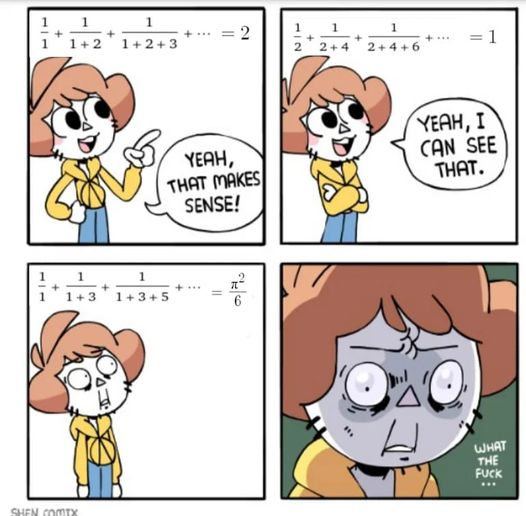this post was submitted on 11 Sep 2024
423 points (97.5% liked)
Science Memes
10340 readers
1840 users here now
Welcome to c/science_memes @ Mander.xyz!
A place for majestic STEMLORD peacocking, as well as memes about the realities of working in a lab.

Rules
- Don't throw mud. Behave like an intellectual and remember the human.
- Keep it rooted (on topic).
- No spam.
- Infographics welcome, get schooled.
Research Committee
Other Mander Communities
Science and Research
Biology and Life Sciences
- [email protected]
- [email protected]
- [email protected]
- [email protected]
- [email protected]
- [email protected]
- [email protected]
- [email protected]
- [email protected]
- [email protected]
- [email protected]
- [email protected]
- [email protected]
- [email protected]
- [email protected]
- [email protected]
- [email protected]
- [email protected]
- [email protected]
- [email protected]
- [email protected]
- [email protected]
- [email protected]
- [email protected]
- !reptiles and [email protected]
Physical Sciences
- [email protected]
- [email protected]
- [email protected]
- [email protected]
- [email protected]
- [email protected]
- [email protected]
- [email protected]
- [email protected]
Humanities and Social Sciences
Practical and Applied Sciences
- !exercise-and [email protected]
- [email protected]
- !self [email protected]
- [email protected]
- [email protected]
- [email protected]
Memes
Miscellaneous
founded 2 years ago
MODERATORS
you are viewing a single comment's thread
view the rest of the comments
view the rest of the comments

tbf, the 2nd sum is exactly the first one just multiplied by 1/2. though i get that the progression is natural, even, and odd.
the last one is definitely ~~odd~~ puzzling, but i cannot intuitively get the first one. how does summing the inverse of triangular number equal 2?
I believe starting with 1/1 which equals 1, you are then adding infinitely (fractions) on top of the 1. So 1, then 1 1/2, ect, so the next full integer to be hit (infinitely down the line) would be 2.
I don't do high level math so I hope this explanation is correct or intelligible, this is just how I understand it intuitively
But the first few values are:
1 + 1/3 + 1/6 + 1/10 + 1/15 + 1/21 + 1/28...
I really don't see any pattern there showing why it converges to 2 exactly
Edit:
After thinking some more, you could write the sum as:
(Sum from n=1 to infinity of): 2/(n * (n + 1))
That sum is smaller than the sum of:
2 * (1/n^2^) which converges to π^2^/3
So I can see why it converges, just not where to.
I didn't see the pattern either and had to look it up. Apparently, you can rewrite 1 + 1/(1+2) + 1/(1+2+3)+... as 2(1 - 1/2 + 1/2 - 1/3 +...+1/n - 1/(n + 1)) = 2(1 - 1/(n + 1))
From there, the limit of 2 is obvious, but I guess you just have to build up intuition with infinite sums to see the reformulation.
So the amount you are adding is getting smaller with each iteration, 1/4 is smaller than 1/2, however you are still adding 1/4 on top of the 1/2, and those two are combined, closer to "1" than either of them independently correct? (1/2 +1/4 =1/3. 1/3>1/2)
So if the number gets bigger forever than at some point it will eventually hit "1", since we already started with "1" the next "1" will be "2"
I hope I'm explaining it well enough, it's similar to how 3.33(repeating)x3...=10 (though technically for different reasons)
Those add to 1.75, just keep adding (infinitely)
It's not saying the proof is obvious, just that the result is plausible on its face.
1/(n * (n+1)) = 1/n - 1/(n+1)
1/(1 * 2) + 1/(2 * 3) + 1/(3 * 4) + ... = 1 - 1/2 + 1/2 - 1/3 + 1/3 - 1/4 + ... = 1
Written a bit more explicitly (although I kinda handwaved away the final term--the point is that you end up with one unpaired term which goes to zero)
edit: I was honestly confused about how exactly this related to the question, but seeing the comment from @[email protected] (not visible from Hexbear) which showed that the first sum in the image is equivalent to
the sum from n = 1 to ∞ of 2/(n * (n + 1))
made things clear (just take the above, put 2 in the numerator, and you get a result of 2)